One STYLE doesn’t suit all!

Apple trees love the cold climate, and orange trees thrive in heat! Try getting an apple tree to blossom in a hot region, or grow oranges in a cold zone, and you are unlikely to succeed. Similarly, people are unique. Each person is defined by his own motivations, values, desires, fears, hopes, preferences, talents, strengths and weaknesses. One person may shine in a customer facing role, as she loves interacting with people, whereas another person may burn out, since the people interface is excessive for him.
The best managers have the ability to understand the individual in all his uniqueness, and accordingly flex their managerial style to bring out the highest performance. Often known as “Different strokes for different folks”, great managers are masters of this technique.
“There is one quality that sets truly great managers apart from the rest: They discover what is unique about each person and then capitalize on it. Average managers play checkers, while great managers play chess. The difference? In checkers, all the pieces are uniform and move in the same way; they are interchangeable. You need to plan and coordinate their movements, certainly, but they all move at the same pace, on parallel paths. In chess, each type of piece moves in a different way, and you can’t play if you don’t know how each piece moves. More importantly, you won’t win if you don’t think carefully about how you move the pieces. Great managers know and value the unique abilities and even the eccentricities of their employees, and they learn how best to integrate them into a coordinated plan of attack” Source - What Great Managers do by Marcus Buckingham https://hbr.org/2005/03/what-great-managers-do
To get a good grasp of what makes an individual tick, it’s important to understand him along the following 3 dimensions:
- Personality and preferences – for e.g., approachable or reserved, detail oriented or big-picture person, a numbers guy or an ideas person, straightforward or tactful, etc.
- Personal circumstances and background – These can significantly impact the person’s values, needs, motivations, hopes and fears – For e.g., a new parent may have different motivations than someone who’s children are in college.
- Competence - typically of 2 types:
Techno- functional – unique to the profession, for e.g., an accountant needs to know accounting techniques, a software programmer needs to know programming languages etc. These competencies are acquired, and are typically impacted by learning and experience.
Cognitive - Behavioural – this includes the innate traits / talents / abilities as well as acquired skills and capabilities For e.g. – intellect, logical reasoning ability, drive for results, emotional self-control, etc.
Of these 3 dimensions, cognitive - behavioural competence has a huge impact on performance, at times even greater than techno-functional, and the manager must have an excellent understanding of this to be able to manage an individual effectively.
MANAGING ACCORDING TO COGNITIVE-BEHAVIOURAL PROFILE
Besides integrity (a non-negotiable requirement), there are 3 fundamental competencies within the cognitive - behavioural competence set that are strongly related to high performance. There will be differences in the strength of each competency required for different jobs, and there are many sub-competencies within each of these competencies. However, broadly speaking, if a manager is able to understand the individual’s proficiency in these 3 competencies, he will get a good grasp of the individual’s cognitive - behavioural competence, including his strengths and weaknesses.
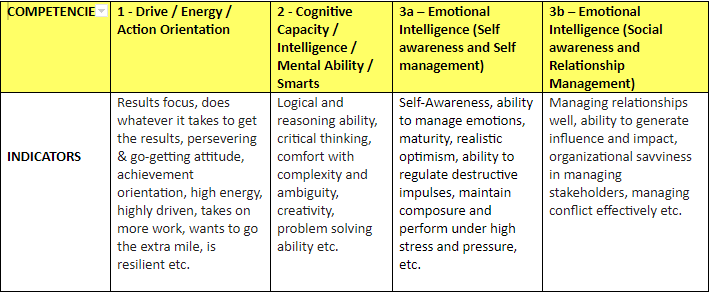
Emotional Intelligence has 2 components (as per Daniel Goleman’s model)
3a – Self awareness & Self Management
3b – Social awareness & Relationship Management
3a and 3b are inter-related, and tend to go together in people. Self awareness and self management is a pre-requisite for relationship management. It is unlikely to find an individual who is low on self awareness & management and has great relationships, or the other way round. The difference is in areas of focus. Self awareness has a greater focus on Self, and Relationship management focusses more on Other People.
Every manager would want his team member to be excellent in all the competencies, but reality is not so perfect! Each individual will be a different combination of highs, mediums and lows in each of these 3 competencies. The first rule of good management is to match strengths to roles. So, individuals with high social intelligence will do well in roles with high-people interface, and people with high cognitive capacity will do well in jobs that involve deep thinking processes.
However, beyond role matching, there is still some degree of each of these competencies that is required in most jobs. That’s why it’s important for the manager to understand the strengths and weaknesses of the individual, and then adapt his managerial style accordingly.
Amongst the 3 competencies, the lack of emotional intelligence probably causes the maximum damage in organizations. Many managers struggle with managing subordinates who have low emotional intelligence. Unfortunately, it is a commonly found weakness, and can even cause workplaces to become toxic. Here are some suggestions on managing an individual with low emotional intelligence:
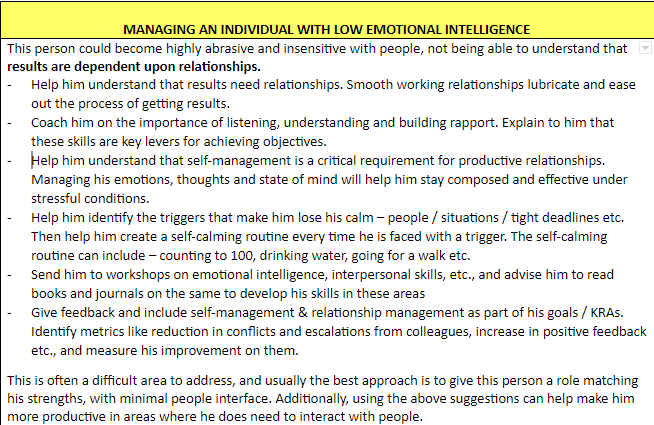
The problem of low emotional intelligence can become even more complicated depending upon the level of the other 2 competencies – Action Orientation & Cognitive Capacity. Here are 3 particularly difficult combinations that a manager may come across, and suggestions on how to flex his management style to manage them effectively.
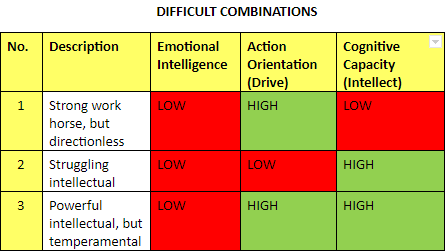
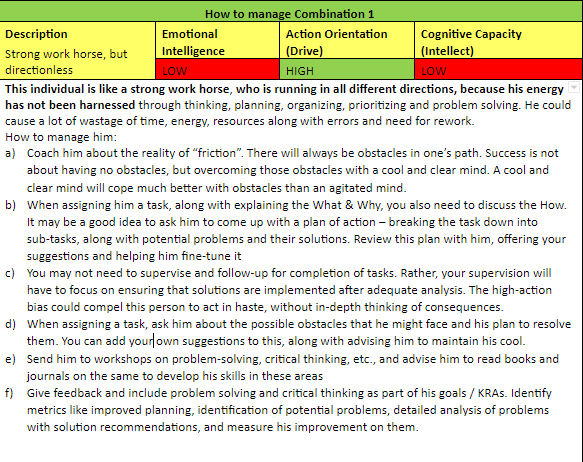
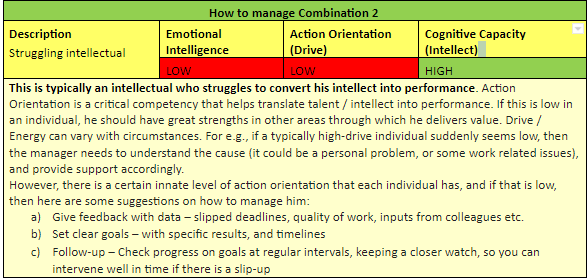

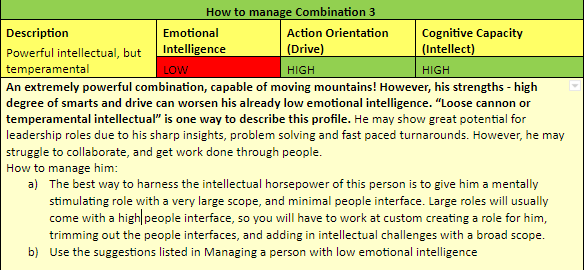
One more combination that can pose a challenge to the manager is where the emotional intelligence is high, but the action orientation is low. Again, role matching is the first solution – assign this person to a role which matches his strengths, but has low pressures of timelines and turnarounds. Plus, use the suggestions given above in combination 2 (managing a person with low action – orientation).
In actuality, the distinctions between people will not be so clearly black and white, fitting neatly into one of these boxes. People within the same box can still be different in some ways, and people in different boxes can be similar in some ways. In fact, people are likely to be far more complex than indicated by the simplicity of these boxes. Likes, dislikes, preferences and personal circumstances of people will add more variety to the cocktail. However, this framework still gives us a way to understand and manage people in terms of performance related competencies. A better manager is one who is able to understand the individual enveloped within all these layers of complexity, and can accordingly flex his managerial style to elicit the best possible performance.















